I never realised that there were so many Islamic sites in Spain until I headed to Andalusia last April. Spain has a rich Islamic heritage due to its historical connections with Al-Andalus (hence the name Andalusia for the autonomous community along the Southern coast), the Muslim-ruled territory that existed on the Iberian Peninsula from the 8th to the 15th centuries. Although many Islamic sites were destroyed or converted after the Reconquista (Morrish rule ended in 1492), some still remain. There are still many notable Islamic sites in Spain including the Alhambra Palace, the Mezquita (Mosque Cathedral) of Cordoba and the Giralda tower of Seville.
The photography in this blog is my own original photography unless otherwise stated – please do not copy, edit or utilise these images without written permission from myself (amy@templeseeker.com). All prices were true at the time of writing (June 2023) but I have included links to the official websites so that you can check for the most updated information.
The most amazing Islamic Sites in Spain at a Glance
The most important Islamic sites in Spain are:
- The Alhambra Palace
- Mezquita of Cordoba
- The Royal Alcazar of Seville
- The Giralda Tower of Seville
- The Alcazaba of Málaga
- Medina Al-Zahra (Cordoba)
- Aljafería Palace (Zaragoza)
If you want to be impressed by Spain’s Islamic architecture, then you really need to spend at least 10 days in Andalusia, with a focus on Grenada, Cordoba and Madrid. Malaga can be added on to the end of this itinerary to see the Malaga Alcazaba. Zaragoza is in the North of Spain and probably best done as a separate trip. Other great destinations to enjoy Arabic architecture in Spain are Toledo and Madrid.
You might also like to check out this article on how to do a 10 day Southern Spain road trip.
#1 The Alhambra Palace
The Alhambra Palace is a magnificent palace and fortress complex in Granada. It is one of the most renowned Islamic sites in Spain and probably in the whole world. It was constructed during the Nasrid dynasty (1232–1492) and showcases exquisite Islamic architecture and design. The Alhambra palace is a UNESCO World Heritage site and attracts millions of visitors every year.
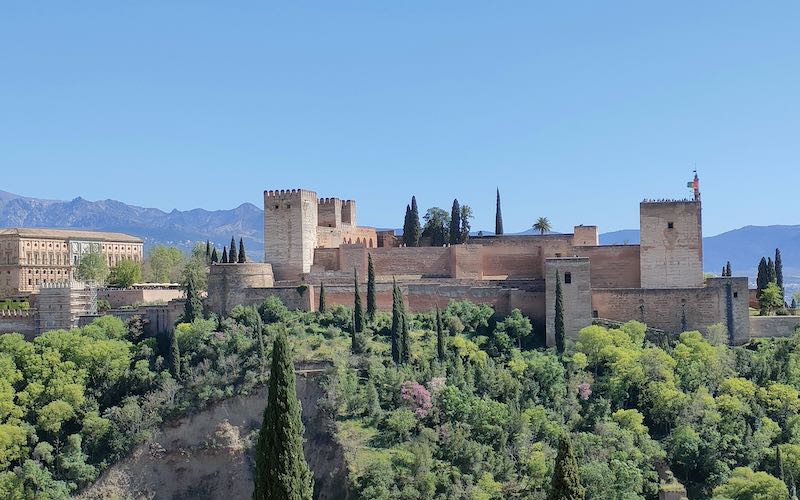
The Alhambra, which means “The Red One” in Arabic, is a fortified palace complex that dates back to the 13th century. It was originally constructed as a fortress on the remains of Roman fortifications. Over time, it was expanded and transformed into a magnificent palace city.
The complex is divided into three main parts: the Alcazaba (the military fortress), the Nasrid Palaces (the residential area of the sultans), and the Generalife (the leisure gardens). The Nasrid Palaces are the highlight of the Alhambra. They consist of a series of interconnected courtyards, halls, and chambers adorned with intricate stucco work, carved wooden ceilings, colourful tiles, and beautiful calligraphy. The most famous among the palaces is the Palacios Nazaríes, which includes the Mexuar, the Court of the Myrtles, and the renowned Palace of the Lions (see below). The Palace of the Lions, with its stunning central courtyard surrounded by a gallery of slender columns and an exquisite fountain, is particularly admired for its architectural beauty.
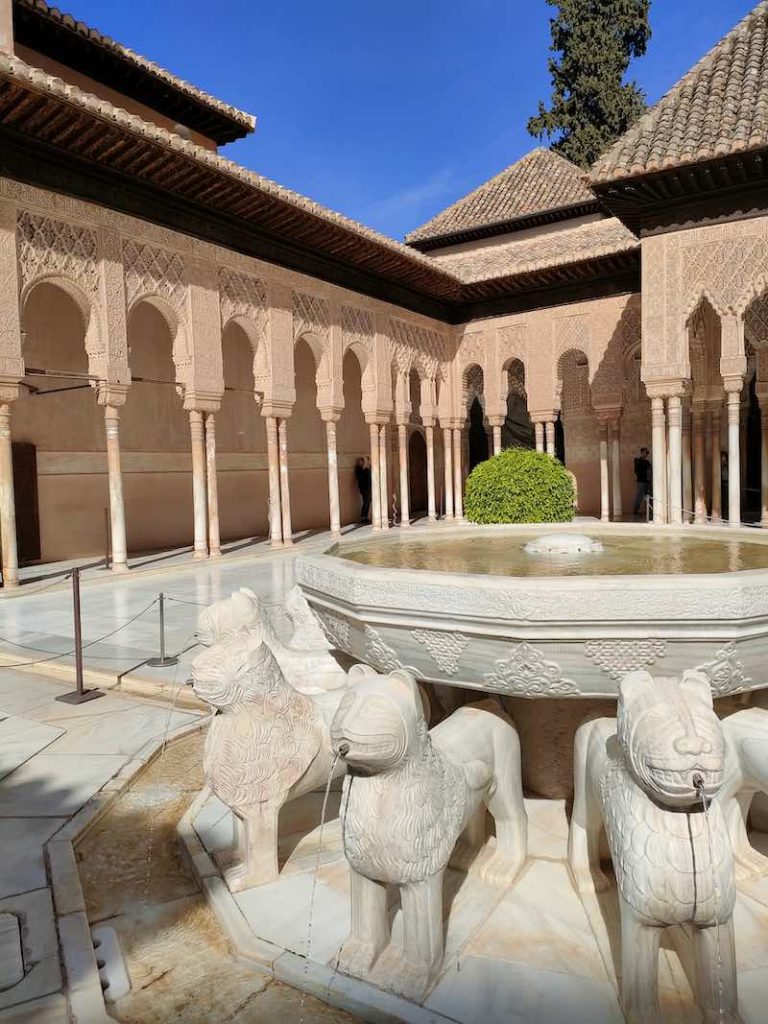
The Generalife, meaning “Architect’s Garden,” is a separate area within the complex that served as the summer residence and leisure retreat for the Nasrid rulers. It features magnificent gardens, fountains, pavilions, and terraces with breathtaking views of the Alhambra and the surrounding landscape. Don’t miss this section of the Alhambra – many people do without realising!
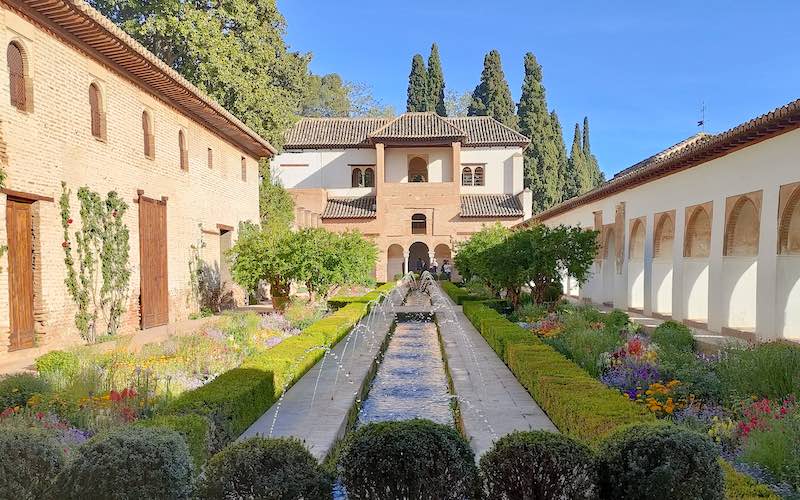
The Alhambra is not only a testament to Islamic architecture but also reflects the blending of different artistic and cultural influences, including Moorish, Christian, and Jewish traditions. The intricate geometric patterns, calligraphy, and decorative motifs found throughout the complex are a testament to the artistic and intellectual achievements of the period.
Travel Tips – book in advance and remember that your ticket is not the time to be at the entrance but the time to be at the Nasrid Palaces. Arrive approximately 1 hour prior to your ticket and explore the Alcazaba first, then make your way to the front of the Nasrid palace queue around 30 minutes before your time with your passport ID. Allow at least 3 hours to explore the Alhambra palace, even better a whole day!
Cost – Buy an Alhambra General ticket online for €19.09 (price as of June 2023)
#2 Mezquita of Cordoba
Known as the Mezquita, the Mosque-Cathedral of Córdoba is a unique architectural marvel and one of the most impressive Islamic sites in Spain. It was initially built as a mosque in the 8th century and later converted into a cathedral. The structure incorporates both Islamic and Christian elements, creating a fascinating blend of styles.
The construction of the Mosque-Cathedral dates back to the 8th century when the Umayyad Caliphate ruled over Al-Andalus. The original mosque was built on the site of a Visigoth church, and subsequent expansions and renovations were carried out over the centuries.
The Mezquita is characterised by its distinctive architectural style, known as the Moorish or Islamic architecture. The most iconic feature of the Mezquita is its expansive prayer hall, which boasts a mesmerising forest of columns and horseshoe arches. There are over 850 columns made of different materials, including jasper, marble, and granite, supporting the roof and creating a unique visual effect. I’ve really never seen anything quite like it.
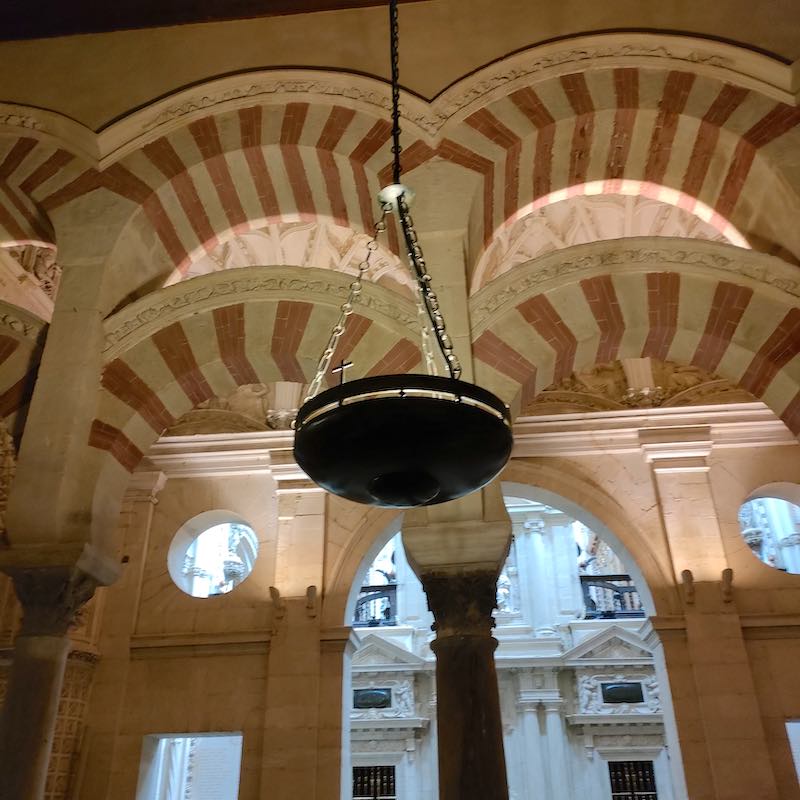
The interior of the Mezquita is adorned with stunning decorative elements, such as intricate geometric patterns, colourful tiles, and beautiful stucco work. The mihrab (a niche indicating the direction of prayer) is exquisitely decorated with intricate mosaics and Qur’anic inscriptions.
After the Reconquista, when Córdoba came under Christian rule, the mosque was converted into a cathedral. Subsequent modifications and additions were made, including the construction of the central nave and the choir. It’s one of the most impressive buildings that I have ever seen in my entire life (and that’s a lot as templeseeker!)
Travel Tips – The Mezquita is free on a Saturday morning from 8.30am or you can book your ticket online here.
Cost: Free (Saturday 8.30am only) or €13 (€10 for concessions).
#3 Royal Alcazar of Seville
The Alcazar of Seville is a royal palace originally built by the Moorish rulers and later expanded by subsequent Christian monarchs. It features beautiful Islamic architecture, including intricate tilework, gardens, and courtyards. It is one of the oldest active royal palaces in the world and is a UNESCO World Heritage site.
The Alcazar’s construction began in the 10th century during the reign of the Moorish Almohad dynasty. Over the centuries, it was expanded and modified by subsequent rulers, including the Christian kings who came to power after the Reconquista.
The palace complex showcases a captivating blend of architectural styles, primarily Islamic (Moorish), Gothic, Renaissance, and Mudéjar. The Almohad influence is most evident in the lower levels of the Alcazar, characterized by their sturdy walls, horseshoe arches, and intricate geometric tilework.
One of the most remarkable features of the Alcazar is the Patio de las Doncellas (Courtyard of the Maidens). It is a rectangular courtyard adorned with beautiful gardens, reflecting pools, and arches. The intricate plasterwork, carved wooden ceilings, and tile decorations create a captivating ambiance.
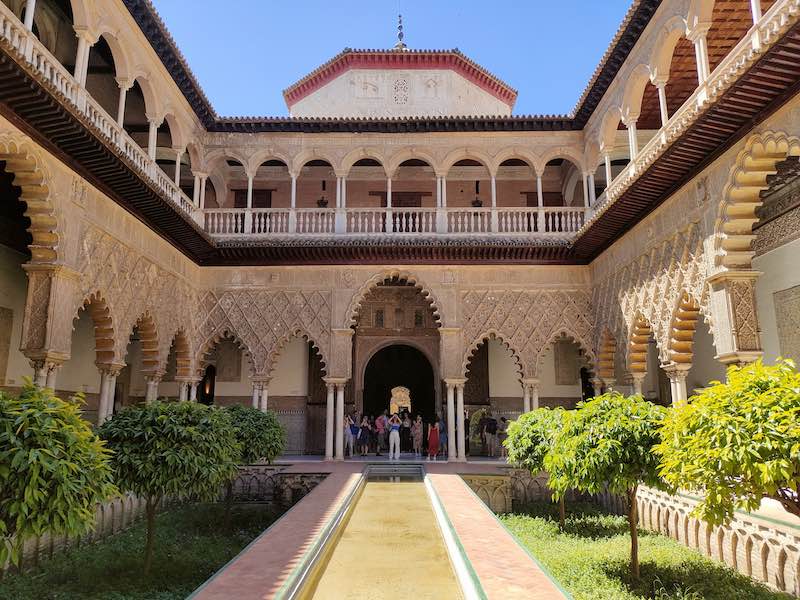
The Alcazar’s interior is equally impressive. The Salón de Embajadores (Hall of Ambassadors) is a grand reception hall featuring a stunning dome adorned with ornate stucco decorations and a star-shaped coffered ceiling. The Salón de los Tapices (Hall of Tapestries) and the Salón de los Reyes (Hall of the Kings) are other noteworthy spaces that showcase lavish decorations and intricate details.
The gardens of the Alcazar, known as the Jardines del Alcázar, are a paradise of tranquility and beauty. They feature lush greenery, vibrant flowers, ornamental ponds, fountains, and charming pavilions. The gardens reflect different architectural styles, from the Islamic-inspired Patio de la Montería to the Renaissance-inspired Garden of the Dance.
The Royal Alcazar of Seville is one of the most beautiful Islamic Sites in Spain and it has served as a residence for numerous monarchs over the centuries and is still occasionally used by the Spanish royal family. The Alcazar has gained additional fame in recent years as a filming location for the TV series “Game of Thrones,” where it served as the setting for the Water Gardens of Dorne.
Travel Tips – You can combine the Royal Alcazar of Seville with a visit to the Seville Cathedral and Giralda. I took this tour with Get Your Guide and it was an amazing day. It gets VERY hot in Seville so take a hat, sun cream and plenty of water.
Cost: Price for entrance-only is €13.00
Giralda Tower (Seville)
The Giralda Tower was originally constructed as the minaret of the Great Mosque of Seville during the Almohad dynasty in the 12th century. It served as the calling tower for the Islamic call to prayer. The tower’s design reflects the distinctive Almohad architectural style, featuring decorative brickwork, arched windows, and geometric patterns.
When the Christian Reconquista took place, the mosque was converted into a cathedral, and the Giralda Tower was preserved as an integral part of the new structure. The tower’s upper levels were later added during the Renaissance period, giving it a unique blend of Islamic and Christian architectural elements.
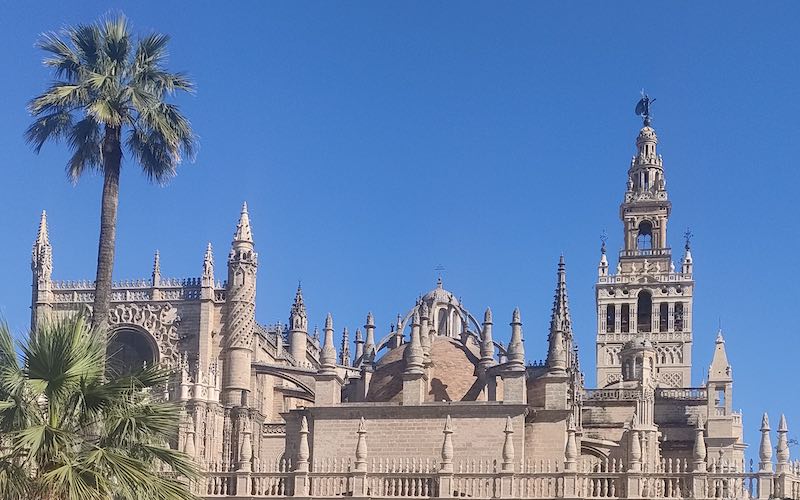
The tower is 104 meters (341 feet) high and is known for its accessibility. I wasn’t sure whether or not I could manage 35 floors, but I was assured that the views would be well worth it. Instead of stairs, you can actually ascend to the top of the tower via a series of 35 ramps. These ramps were designed to allow the muezzin (the person who performs the call to prayer) to ride a horse to the top, making it easier to reach the high vantage point. Therefore the Giralda tower is much easier to climb than you might expect!
At the pinnacle of the Giralda, you will be rewarded with these stunning panoramic views of the city of Seville. From this elevated vantage point, you can admire the city’s historic centre, the Cathedral’s intricate architecture, and the surrounding landscapes.
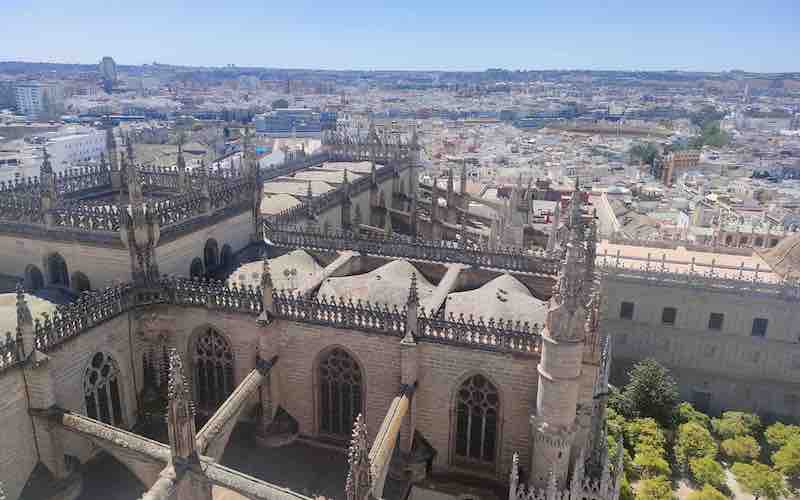
Travel Tips – The Giralda needs either a separate ticket or buy a combined ticket for the Cathedral plus Giralda. The ramps are easier to climb than steps so have faith that you can do it!
Cost: The full adult ticket to Seville Cathedral and Giralda tower costs €16
Alcazaba of Málaga
The Alcabaza of Malaga stands as one of the most well-preserved citadels from the Islamic era in Spain. The Alcazaba, along with the nearby Gibralfaro Castle, is a formidable defensive complex overlooking the city and the Mediterranean Sea.
Construction of the Alcazaba began in the 8th century when Málaga was under Muslim rule. It was built on the remains of a previous Roman fortification and served as a defensive structure, residence for rulers, and a symbol of power. The fortress underwent expansions and modifications over the centuries under various Muslim dynasties, including the Almoravids and the Nasrids.

The Alcazaba is known for its impressive architectural features, blending elements of Moorish and Romanesque styles. The fortress is characterised by its fortified walls, imposing towers, intricate stonework, and beautiful gardens.
As you enter the Alcazaba, you’ll pass through a series of fortified gates and walls, leading you into an enchanting world of lush gardens, tranquil courtyards, and ornamental pools. The inner courtyards are adorned with fountains, citrus trees, and vibrant flowers, creating a peaceful oasis in the heart of the city.
The palace within the Alcazaba houses various rooms and chambers that showcase exquisite Islamic architectural details. You can explore the Patio de los Surtidores (Courtyard of the Surtidores), the Patio de los Arrayanes (Courtyard of the Myrtles), and the Sala de los Reyes (Hall of the Kings), among others. These spaces feature beautiful arches, intricate stucco work, and decorative tiles that reflect the artistic and cultural sophistication of the period.
The Alcazaba offers magnificent views of the city, the port, and the surrounding landscapes from its elevated position. You can climb to the top of the fortress and walk along the ramparts, providing a panoramic perspective of Málaga and its coastal scenery.
Travel Tips – Go on foot as the Alcazaba is easily reached by walking from Malaga’s main historic centre. There are also direct flights to Malaga airport from Liverpool!
Cost: €3,50 one monument or €5,50 for the combined Alcazaba and Gibralfaro ticket.
Medina Al-Zahra – Cordoba
Medina Al Zahra was once a grand palatial city built by the Caliph Abd ar-Rahman III near Córdoba. Though largely in ruins now, the archaeological site offers glimpses of the opulence and grandeur of the Umayyad dynasty. When you walk through the amazing arches and pathways that remain, it’s easy to imagine the spleandour of this city that once was.
Construction of Medina Al zahra began in 936 CE under the orders of Caliph Abd al-Rahman III, who sought to establish a grand political and cultural centre. The city was named after his favourite wife, Azahara. Medina Al-Zahra was designed to showcase the power and wealth of the Caliphate, and it served as the seat of the government.
The complex was built on a strategic hillside, overlooking the Guadalquivir River and offering stunning views of the surrounding landscape. It consisted of royal residences, administrative buildings, gardens, mosques, and public spaces.
Medina Azahara boasted remarkable architecture and lavish decorations. The buildings were adorned with exquisite mosaics, carved stucco, colorful tiles, and intricate calligraphy, showcasing the artistic brilliance of the time. The grandest structure was the Aljama Mosque, which featured a vast prayer hall, a courtyard, and an impressive minaret.
The city was designed with a sophisticated urban layout, featuring wide avenues, gardens, and water features. The water supply system was a marvel of engineering, utilizing aqueducts, reservoirs, and fountains to provide water to the entire complex.
Unfortunately, Medina Azahara’s glory was short-lived. It was sacked and looted in 1010 during political unrest, and gradually fell into ruin over the centuries. The site was rediscovered in the early 20th century and has undergone extensive archaeological excavations and restoration efforts since then.
Today, Medina Azahara is an archaeological park and UNESCO World Heritage site. You can explore the partially reconstructed ruins, walk through the ancient streets, and admire the remnants of its former grandeur. The on-site museum displays artefacts discovered during the excavations, providing insights into the daily life, culture, and artistry of the Umayyad Caliphate.
Note that there is very little shade on the side of Medinat Al-Zahra and so a sun hat, sun cream and plenty of water is essential. The visit is a half day trip (or even a full day) from Cordoba.
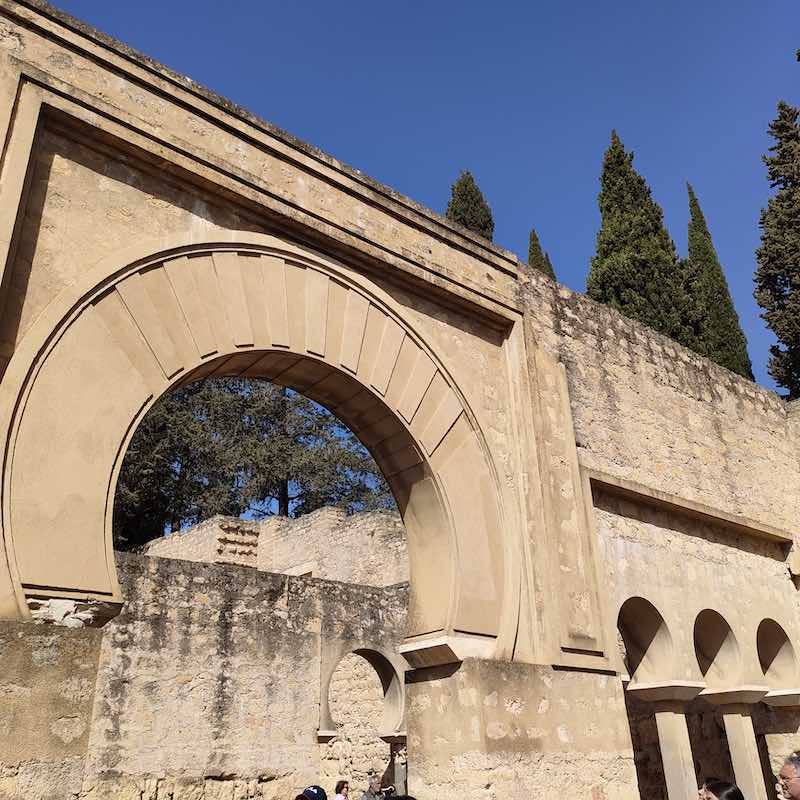
Travel Tips – This can be done as a day trip from Cordoba. Take the Medina Al-Zahra yellow bus to the bottom of the hill where you buy your ticket and explore the museum. Then you will take the green transfer bus up the hill to see the ancient city ruins. For the full blog click here.
Cost: it will cost €10 in cash walk on price but just €9,50 if you book online with Tourism de Cordoba here (bus from Cordoba needs to be paid for separately but the green transfer bus up the hill is included in that ticket).
Aljafería Palace (Zaragoza)
The Aljafería Palace, located in Zaragoza, Spain, is an extraordinary architectural gem that reflects the diverse history of the region. The palace was originally built as a fortified residence for the Muslim rulers of the Taifa of Zaragoza in the 11th century.
The Aljafería Palace is renowned for its unique blend of Islamic, Romanesque, Gothic, Mudéjar (Islamic partly gothic), and Renaissance architectural styles. It showcases the influences of different cultures that have shaped the history of the Iberian Peninsula.

The palace complex consists of several interconnected structures and courtyards. One of its most notable features is the Tower of Troubadours (Torre del Trovador), an impressive octagonal tower that serves as the palace’s main entrance. The tower features intricate brickwork, decorative arches, and ornamental details.
Inside the palace, you can explore various rooms and halls that exhibit beautiful Islamic architectural elements, including stucco decorations, horseshoe arches, and intricate geometric patterns. The Palace of the Catholic Kings (Palacio de los Reyes Católicos), added during the Christian rule, showcases Renaissance-style additions, such as the elegant Patio de Santa Isabel.
The palace underwent significant renovations and modifications over the centuries. After the Christian Reconquista, it became the residence of the Aragonese monarchs and underwent transformations in accordance with Renaissance and Gothic styles. Today, it serves as the seat of the regional parliament of Aragón.
Visiting the Aljafería Palace allows you to immerse yourself in the rich history of Spain, appreciating the fusion of architectural styles and the cultural significance of the palace. Its historical and artistic value earned it the designation of a UNESCO World Heritage site in 2001.
Travel Tips – It is best to go on the official website to reserve your tickets (you choose the day and the time). The price is €5 Euros but that is only a reservation – you will pay when you pick up the tickets at the ticket office outside the Palace (from https://mappingspain.com/aljaferia-palace-zaragoza)
Cost: €5
These are just a few examples of Islamic sites in Spain. The country has numerous other places with Islamic influences, including mosques, fortresses, and historic neighbourhoods in cities like Toledo and Almería. Exploring these sites provides a deeper understanding of Spain’s Islamic past and its cultural heritage.
Further Reading on Spain
If you enjoyed this article on Islamic sites in Spain, then you might also like to read:
- 10 Beautiful Churches in Seville – The capital of Andalusia
- Visiting the Alhambra Tips – Spains most Famous Monument
- Córdoba Patio Festival (La fiesta de los patios)
- Seville Alcazar and Cathedral tour – An Awe Inspiring Experience

